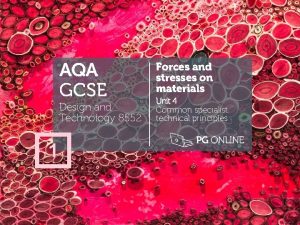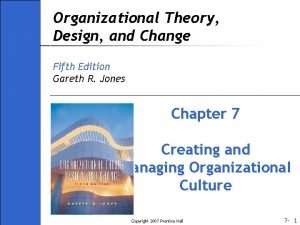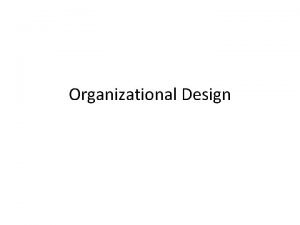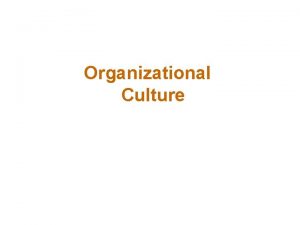Lecture 31 2 Organizational design and technology Organizational









- Slides: 9

Lecture # 31

2. Organizational design and technology • Organizational design consists of the decisions about … formal structures, processes, systems, roles and relationships • Change in strategy , goals will lead to change in structure , functional , divisional or matrix type of structures, hierarchical levels 5(growth or technology), degree of centralization and delegation, formal planning and control systems, and job specialization, education and training • Flexibility of structure is an imp. variable comprises - flow of information (old paradigm-that top managers are most informed), rewards (performance linkage) and recruitment (internal or external

• How people use technology and willing to learn newer production technologies is crucial in the job design – because readiness for change depends on this. • Extent of technology promotion itself depend on how people are socially linked to each other and to the technical system of an org. Of particular interest is - How the knowledge of work procedures (software) are synchronized with the mode of production (e. g. small batch process), The physical layout of the facilities (e. g. line activities versus station layout) and means of transformation (e. g. specialized versus multipurpose)

3. Management Practices and org culture – such practices conducive org mission and vision or for organization change and productivity - Rules, principles and routine – how people do work - System disconnect if practices are not related with mission of organization Or people are unable to give meanings to rules and regulations of organization and larger goals of the organization Or People are least motivated to do their jobs - Or there is no perceived linkage between performance and reward linkage - Authority but not accountability is built in job-design - Unwritten rules and conventions - Culture – conservative or innovative, trust worthiness or trust-deficit, discipline, socialization and tolerance for ambiguity

SOC process – two models 1. OD models 2. Behavioral modifications OD model - OD is a distinct area within the field of organizational science that focuses on the planned and controlled change of organizations in desired directions In essence, OD attempts to change an organization as a totality by changing the organization’s structure, technology, people, and/or tasks. (changing people or changing tasks, structure and technology to be focused) One popular model is Kurt lewin ‘s model and force field analysis 2. The behavior modification (BM) intervention is the normative essence of the wider concepts of motivation, reward, learning and organizational culture (Wilson, 1992). This second school of thought has its roots in the practices of behavior modification and is an attempt to understand reduce complex change processes in the organization to explicit rules, procedures, and strategic actions to deal with all possible contingencies

Leadership and strategic organizational change -Leadership and technology -Leadership and middle management -Learning -Motivation, Productivity and Strategic Change

Determinants of Successful organizations Environmental Structural Management orientation 1. Customer is taken care of –focus on customer needs-superior service to customers – do not forget that org exist for customers 2. Adapt their structure to organization mission – control may be loose and tight, at departmental level – loose in the sense of autonomy given and tight in the sense of setting up of high performance goals Highly successful org operate with simple and appropriate structure and adequate staff –instead of empire building

- Entrepreneurship and risk taking is encouraged at divisional level and innovation being rewarded - Goal attainment is preferred over paralysis through analysis of alternatives –instead satisficing action that ensures goal attainment is encouraged - Sticking to one’s knitting – to original arena of org –instead of being led by different attractive alternatives - Stress upon the single value – quality product that is minimizing cost and satisfying the unique need of the customer. (that single/dominant value is highlighted in the promotion and training of employees - Finally successful org –seek consensus of employee- agreement over performance goals

Determinants of failure in organization - Environmental – Change in technology e. g. technological innovation of competitors and loss of business - Dependency on supplier, and on single customer Structural – Inadequate control mechanism –may not able to sense change result in poor product quality and loss of customer • Management orientation - Indecisive leadership (half hearted) = a tendency to overanalyze data or to take a “wait-and-see” attitude may cause a firm to lose ground to competitors and may exacerbate internal problems. - New hiring ignored especially of professional mangers –to revitalise org through innovation (fresh thinking) • Thought simplistic but the author analysis show that Environmental factors are more likely to pose potential threats to an organization’s well-being, while structural factors are an organization’s major means of achieving success or, at least, coping with threats.
 01:640:244 lecture notes - lecture 15: plat, idah, farad
01:640:244 lecture notes - lecture 15: plat, idah, farad Type of forces in technology
Type of forces in technology Eurocode 2 lap length table
Eurocode 2 lap length table Elemen urban design
Elemen urban design Principles of design in interior design ppt
Principles of design in interior design ppt Lecture hall background
Lecture hall background Game design lecture
Game design lecture Computer-aided drug design lecture notes
Computer-aided drug design lecture notes Cmos vlsi design lecture notes
Cmos vlsi design lecture notes Organizational theory design and change
Organizational theory design and change

















